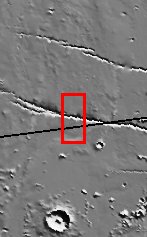
Released August 30, 2004
The THEMIS Image of the Day will be exploring the nomenclature of Mars for the next three weeks.
Cerberus Fossae
- Fossae: long, narrow, shallow depressions
- Cerberus: The three-headed watchdog that guarded the entrance to Hades. Cerberus was the child of a giant and a half-woman/half-snake.
Cerberus Fossae is comprised of two east/west oriented linear depressions. One of these depressions is shown in the VIS mosaic above. The region surrounding the depression is mainly volcanic in nature.
Nomenclature Fact of the Day: Since the planet Venus is named for the Roman goddess of love, its features are named with female names. Large craters are named for famous women, small craters are named with female first names, and other features are named for mythological goddesses of many cultures.
Image information: VIS instrument. Latitude 10.1, Longitude 157.3 East (202.7 West). 19 meter/pixel resolution.
Note: this THEMIS visual image has not been radiometrically nor geometrically calibrated for this preliminary release. An empirical correction has been performed to remove instrumental effects. A linear shift has been applied in the cross-track and down-track direction to approximate spacecraft and planetary motion. Fully calibrated and geometrically projected images will be released through the Planetary Data System in accordance with Project policies at a later time.
NASA's Jet Propulsion Laboratory manages the 2001 Mars Odyssey mission for NASA's Office of Space Science, Washington, D.C. The Thermal Emission Imaging System (THEMIS) was developed by Arizona State University, Tempe, in collaboration with Raytheon Santa Barbara Remote Sensing. The THEMIS investigation is led by Dr. Philip Christensen at Arizona State University. Lockheed Martin Astronautics, Denver, is the prime contractor for the Odyssey project, and developed and built the orbiter. Mission operations are conducted jointly from Lockheed Martin and from JPL, a division of the California Institute of Technology in Pasadena.

 Planetary Data System
Planetary Data System













